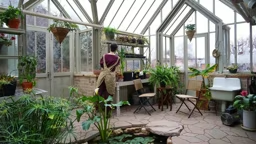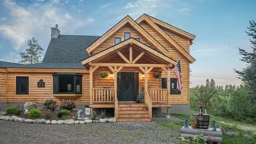
This easy to create DIY vertical garden will liven up any garden. The trick is a length of rebar threaded through the drain holes in the bottoms of the pots, but the effect is a precariously balanced stack of pots if the rebar is hidden well. Here's a step-by-step guide so you can create a DIY vertical garden of your own.
DIY Vertical Garden in 8 Steps
1. Find the right spot and pick your plants.
Because your plants will be grouped and stacked, it's wise to choose varieties that require similar sun, water and soil conditions. Choose a potential spot and observe it at several points throughout a sunny day to see if it will provide a full-sun, partial-sun, or fully shaded environment for your planter.
I decided to create a red, white and blue effect for a patriotic summer theme, so I chose flowers in those colors as well as a few herbs and other accent plants for interest. Although the specific needs of each plant varied slightly, they all required full sun and frequent watering, so their care should be uniform and easy to manage.
2. Measure your pots and rebar.
As you choose your plants and their respective pots, add up the lengths of each pot's side. To ensure that your stake will create a solid, well-grounded backbone for your pots all the way to the top, you will need your rebar to exceed the total side length from all of your pots by about 14 to 16 inches.
Although "standard" flower pots have top diameters equal to their height, this standard can vary, so it's best to take your own measurements to be sure.
My local garden and home improvement shops only sold rebar in 2-, 4- and 10-foot lengths, so I substituted a 6-foot reinforced garden stake. For the pots, I worked with one 9-inch, two 8-inch, two 7-inch, two 6-inch and one 5-inch pots, which added up to a side length of 56 inches for a 72-inch stake.
3. Hammer your rebar into your selected plant site.
The stake or rebar will have to be buried at least 10 inches into tightly packed earth for stability. To know when it has reached this point, measure 10 inches from the bottom of the stake and mark the line with a permanent marker, twist-tie or other indicator, then hammer it in until this line reaches ground level. Ensure that the stake is completely vertical, solidly buried and far enough away from any fence or obstruction that you'll be able to fit your pots easily.

4. Thread your bottom pot onto the stake.
I decided to stagger the pots in my vertical garden from largest at the bottom to smallest at the top for a graduated effect, but you can use pots of the same size or even mix up the sizes for an even more mysterious illusion.Once your first pot has been threaded onto your stake, tilt it so the lip rests against the stake.
5. Begin planting.
Your plants may require a special growing medium, such as sandy or slightly acidic soil, but in general, an all-purpose potting soil serves most common garden plants well. Fill your bottom pot with soil, making sure to fill the space behind the stake. Break up the roots of your plant and work it into the dirt.
6. Stack your second pot.
Carefully thread your second pot above the first. Once it has reached the bottom, balance the pot so it tilts in the opposite direction of the first. Fill this pot with soil and plant your next selection.
7. Repeat to the top.
The ground on my planting site was baked dry and hard to penetrate, so my stake was only buried perhaps six inches deep.As you can see, the stake had already developed a lean by the time I added the second pot. To reinforce and straighten it, I tied the stake to the fence behind it below the third (from bottom), fifth and sixth pots.
Believe it or not, pantyhose is a great tie-up for gardening purposes. It's strong but flexible enough to provide solid support, giving you a great way to recycle old hose otherwise ruined by a snag. If you've measured well, the stake should peek out of the top pot by only a few inches, which can easily be obscured by a leafy plant.











